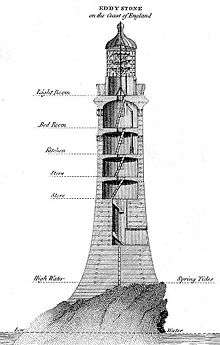Smeaton's Tower
| Smeaton's Tower | |
|---|---|
 | |
| General information | |
| Type |
former lighthouse and memorial |
| Location | Plymouth, Devon, South West England |
| Coordinates | 50°21′52″N 4°08′31″W / 50.36441°N 4.14183°WCoordinates: 50°21′52″N 4°08′31″W / 50.36441°N 4.14183°W |
| Completed | 1759 |
Smeaton's Tower is the third and most notable Eddystone Lighthouse. It marked a major step forward in lighthouse design. In use from 1759 to 1877, it was largely dismantled and rebuilt on Plymouth Hoe in Plymouth, Devon, where it now stands as a memorial to its designer, John Smeaton, a celebrated civil engineer.
Construction


The Royal Society recommended Smeaton to the task, who modelled the lighthouse on an oak tree. He rediscovered the use of "hydraulic lime," a form of concrete used in Roman times. The technique allowed concrete to set under water, as Smeaton put granite blocks together using dovetail joints and marble dowels.[1] Construction started in 1756 at a site in Millbay, where Smeaton built a jetty and a workyard in southwestern corner of the harbour to unload and work on stones. Timber rails of 3 ft. 6 in. gauge were laid for four-wheeled flat trucks, which were used to move masonry around the site. A 10-ton ship named the Eddystone Boat was based here, and transported worked stones out to the reef. The ship carried the 2¼-ton foundation stone out in the morning of 12 June 1756.[2]
The work was completed in August 1759 at a cost of £40,000 (£5,525,926 with inflation[3]).[4][5] Many Cornish tin miners were employed in its construction. To avoid the possibility of press ganging, a practice which was common at the time, Trinity House arranged with the Admiralty that the workers would be immune from the press. Each worker was issued a medal to confirm he was a worker at the lighthouse.[1]
The lighthouse was 72 feet high, and had a diameter at the base of 26 feet (8 metres) and at the top of 17 feet (5 metres).[6]
History
After the structure was completed, the lighthouse's 24 candles were lit on 16 October 1759.[1] Each candle weighed between 2 pounds (0.91 kg) and 5 pounds (2.3 kg). A timepiece placed alongside the light was set to chime every half-hour, alerting the lighthouse keeper of the need to replace expired candles.[7]
The lighthouse candles were replaced by oil lamps and reflectors from 1810.[7] Further major renovations were carried out in 1841 by engineer Henry Norris, including the filling of a hole in the rock close to the tower's foundation. [8] The lighthouse remained in use until 1877 when it was discovered that rocks upon which it stood were becoming eroded. Each time a large wave hit, the lighthouse shook from side to side.
Smeaton's Tower ceased operation in 1879 with the illumination of Douglass's Tower on an adjacent rock.[7] In 1882 the upper part of Smeaton's Tower was dismantled and rebuilt as a memorial to Smeaton on a new base on Plymouth Hoe,[9] replacing the triangular obelisk that had been built there by Trinity House as a navigation aid in early 19th century.[10] It was opened to the public by Mayor of Plymouth on 24 September 1884.[11]
The foundation and stub of the old tower remain on Eddystone Rocks, close to the current lighthouse.[4] Since the foundation proved too strong to be dismantled, Victorians left it where it stood. The lighthouse was depicted on British penny coins from 1860 to 1894, and again from 1937 to 1967.
An 1850 replica of Smeaton's lighthouse, Hoad Monument, still stands above the town of Ulverston, Cumbria as a memorial to naval administrator, Sir John Barrow.
Current use

Smeaton's Tower has been a Grade I-listed building since 1954.[9] It is open for visitors, who may climb 93 steps, including steep ladders, to the lantern room, and observe Plymouth Sound and the city. It also has an active Twitter account @smeatonstower.[5][12]
References
- 1 2 3 "Eddystone - Gallery". Trinity House. Retrieved 2010-05-03.
- ↑ Langley, Martin (1987). Millbay Docks (Port of Plymouth series). Exeter: Devon Books. pp. 1, 3. ISBN 0-86114-806-1.
- ↑ UK CPI inflation numbers based on data available from Gregory Clark (2016), "The Annual RPI and Average Earnings for Britain, 1209 to Present (New Series)" MeasuringWorth.
- 1 2 Majdalany, Fred: The Eddystone Light. 1960
- 1 2 "Plymouth City Museum and Art Gallery - Smeaton's Tower". Plymouth City Council. Retrieved 2010-05-03.
- ↑ "Lighthouse management : the report of the Royal Commissioners on Lights, Buoys, and Beacons, 1861, examined and refuted Vol. 2". p. 88.
- 1 2 3 Clowes, William Laird (1898). The Royal Navy: A History From the Earliest Times to the Present. 3. London: Sampson, Low, Marston and Company. pp. 14–15. OCLC 645627800.
- ↑ "Woolmer's Exeter and Plymouth Gazette". 15 May 1841. p. 3.
The Eddystone Lighthouse has within the past few months undergone a complete renovation, under the direction of Mr. Henry Norris, engineer...a large cavity in the rock, close to the foundation of the light-house has been filled up
- 1 2 "Images of England – The Smeaton Tower". English Heritage. Retrieved 2009-06-30.
- ↑ Moseley, Brian (April 2013). "Trinity House Obelisk". The Encyclopaedia of Plymouth History. Plymouth Data. Archived from the original on 28 September 2013. Retrieved 13 February 2015.
- ↑ Moseley, Brian (August 2007). "Smeaton's Tower". The Encyclopaedia of Plymouth History. Plymouth Data. Archived from the original on 16 March 2011. Retrieved 13 February 2015.
- ↑ "Plymouth City Museum and Art Gallery - Smeaton's Tower visitor information". Plymouth City Council. Retrieved 2010-05-03.
External links
| Wikimedia Commons has media related to Smeaton's Tower. |
- Smeaton's Tower - official site